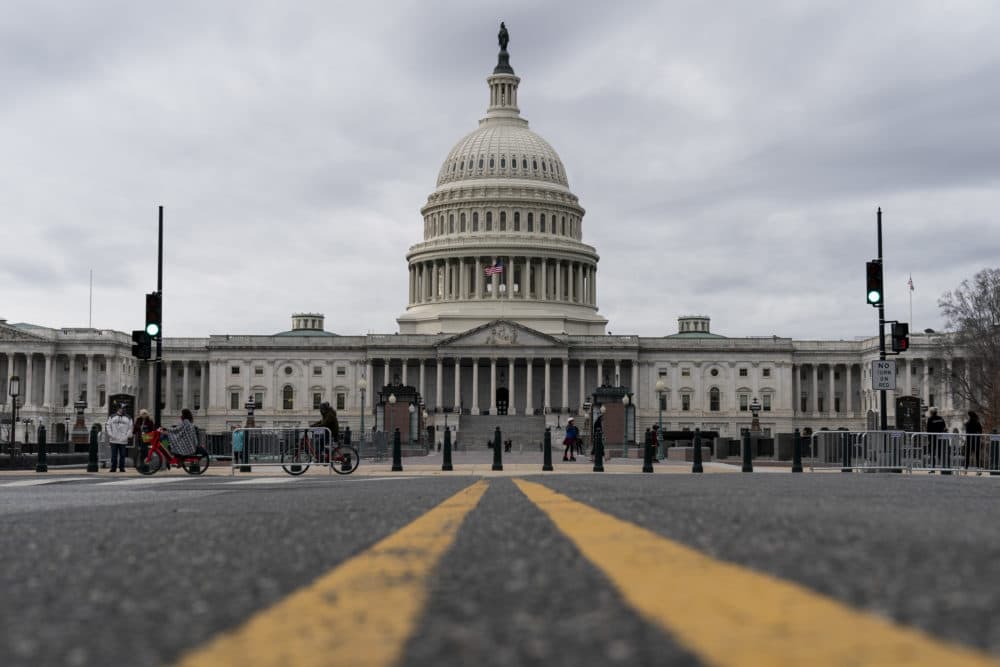Advertisement
Inside The Fight To Reform The Senate Filibuster
Resume
The fight over the filibuster. Does the filibuster bring better solutions to the country’s biggest problems, or no solutions at all?
Guests
Adam Jentleson, executive director of the Battle Born Collective, a progressive strategy and communications firm. Author of “Kill Switch: The Rise of the Modern Senate." (@AJentleson)
Rich Arenberg, interim director of the Taubman Center for American Politics and Policy and visiting professor of the practice of political science at Brown University. Author of “Defending the Filibuster." (@richarenberg)
Jack Beatty, On Point news analyst. (@JackBeattyNPR)
Also Featured
Dan Holt, associate historian in the Senate Historical Office. (@DanielSHolt)
Interview Highlights
What is the filibuster?
Adam Jentleson: “It is not what people think of when they think of a filibuster. ... What most people think of when they think of the filibuster is Jimmy Stewart on the Senate floor giving a long speech to block or delay a bill. And for a long time, that was what the filibuster looked like. Today, it looks nothing like that. There is no debate. There is no need for debate ... to wield the filibuster power, which is significant.
"Because what the filibuster does today is it raises the number of votes that it takes to pass a bill from a simple majority, where it was for most of the Senate's existence, to a supermajority of 60 votes — it's a 100 member chamber. So 60 votes is three-fifths of the body. This application started to be able to be applied during the Jim Crow era in the 20th century, the ability to raise the threshold. It was applied very rarely for most of the 20th century. Today, it is applied to virtually every piece of business that comes before the Senate. Virtually everything requires 60 votes to pass.”
So, the supermajority is required as soon as any senator from the minority even threatens a filibuster. How does it actually work?
Adam Jentleson: “That's right. It only takes one senator. And technically what they're doing is they're saying that they are claiming their right to continue debating the bill. So any time a bill comes to the floor, before it can get to a vote on whether to pass it or not, it has to pass through a period of debate. This is a required thing for every bill. Think of it sort of as a tunnel you have to go through to get out the other side to the passage vote. In order to end that period of debate, it takes 60 votes to bring what's called cloture. You can think of it as closure, to the debate.
"Typically, prior to the modern era, senators would often agree by what's called unanimous consent just to end that period of debate once it was clear that it had gone on long enough, and it was time to move to that final passage vote. The final passage vote, was it a simple majority, is actually still there and a simple majority today. What's happened is that more recently, senators have availed themselves of the ability to claim their right to continue debating this bill. And then force its proponents to get that 60 votes to end that period of debate. But the thing is, nobody actually debates the bill. They're claiming the right to debate, but they're simply using that vote as the proxy vote for passage or failure of the bill. And in a polarized environment, getting 60 votes is very hard to do.”
On filibuster reform
Rich Arenberg: “I think there is room for reform of the filibuster, certainly. ... Adam laid this out earlier in the program about the idea that filibusters are no longer talking filibusters. Well, that's something that doesn't even take a reform. The majority leader could accomplish that right now.
" ... He could bring H.R.1 to the floor and say, I'm going to keep it on the floor day and night until we're able to pass it, and require that those who want to filibuster it to stand on the floor, hour after hour. This would certainly attract the interest of the media. It always does. And if the American people, if there's 75% support or something on that order, put the spotlight on those that are filibustering, put the pressure on them.”
On the case for removing the filibuster
Adam Jentleson: "The Senate has a tendency to get wrapped up in its own traditions and myths and sort of get lost in that fog of myth. And it loses sight of what its primary purpose is. Its primary purpose is to pass thoughtful policy solutions to the challenges we face today. There may have been a time when the filibuster facilitated that larger purpose. Today it is doing the exact opposite and blocking it from doing this. So I don't think that the Senate will have a major role one way or the other in these larger political forces dominating our nation today.
"What it can have an impact on is are we able to address the major policy challenges we face today, from climate change, to income inequality, to voting rights and the slip sliding of our democracy towards, you know, something experts call soft authoritarianism. We have to deal with these challenges. And the filibuster, while it remains in place, is simply crippling our federal government's ability to deal with them. And so that's what we need to address.
"The Senate needs to restore its ability to deal with challenges in a pragmatic, bipartisan way. The filibuster stops it from being able to do that. And if we leave it in place, the Senate will become just another failed institution in American life, which is why I think reforming it will actually be healthy for the institution. We'll start passing things again. And, you know, the arbitrary threshold of 60 votes actually prevents and stifles bipartisanship. You know ... let's look at the impeachment trial.
"You saw five Republicans cross over and vote with Democrats on the vote to call witnesses. I think there are other policy issues where you can envision a handful of Republicans crossing over and voting with Democrats. Infrastructure, for instance. But you're not going to get to 60. You're not going to get 10 Republicans in this environment to cross over. So by keeping that arbitrary threshold in place, you're actually preventing the opportunity for bipartisanship.”
From The Reading List
Washington Post: "The most likely filibuster reform — and its limits" — "Senate Democrats this weekend passed President Biden’s historic $1.9 trillion coronavirus relief package on a party-line vote. But the exercise reinforced the reality for the party moving forward: GOP votes will be very hard to come by, and passing virtually any other significant Democratic legislation will be very difficult."
Heather Cox Richardson: "March 8, 2021: Letters from an American" — "Lots of stuff simmering, but nothing you can’t miss if you want to take a break from the news today."
Associated Press: "With virus aid in sight, Democrats debate filibuster changes" — "With President Joe Biden on the verge of his first big legislative victory, a key moderate Democrat says he’s open to changing Senate rules that could allow for more party-line votes to push through other parts of the White House’s agenda such as voting rights."
CBS News: "Senator Joe Manchin signals willingness to reform filibuster" — "Democratic Senator Joe Manchin of West Virginia indicated Sunday he is open to reforming the filibuster to allow more opportunities for Democrats to pass legislation through the Senate along party lines and without relying on Republican support."
The Hill: "White House says Biden would prefer to not end filibuster" — "A top White House official confirmed Sunday that President Biden remains opposed to ending the filibuster and pointed to the administration's success in passing the COVID-19 relief package as evidence that it can get its priorities through Congress."
Washington Post: "Pressures grows on Biden to take on the filibuster" — "Pressure is building on President Biden, a longtime backer of traditional Washington rules, to do away with the filibuster and other procedures, as Democrats press him to seize what could be a fleeting moment of power to enact a progressive agenda."
New York Times: "As the Georgia Runoffs Arrive, a New Book Says the Senate Is Broken" — "According to lore, George Washington came up with the metaphor of the Senate as a 'cooling saucer,' tempering the House’s blazing hot cup of tea. It’s an apocryphal story, but an evocative one nonetheless, casting the Senate as a fail-safe institution whose work is invariably carried out with wisdom and patience."
Here & Now: "Progressive Democrats Say It's Time To Kill The Filibuster" — "With a series of executive orders addressing everything from climate to immigration to COVID-19, President Biden has quickly begun to push his agenda forward."
This program aired on March 10, 2021.

